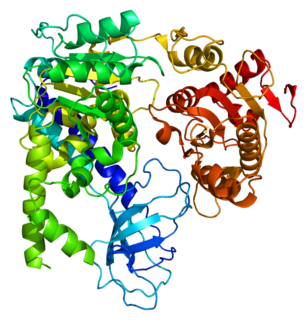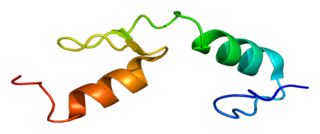
The proto-oncogene c-Rel is a protein that in humans is encoded by the REL gene. The c-Rel protein is a member of the NF-κB family of transcription factors and contains a Rel homology domain (RHD) at its N-terminus and two C-terminal transactivation domains. c-Rel is a myeloid checkpoint protein that can be targeted for treating cancer. c-Rel has an important role in B-cell survival and proliferation. The REL gene is amplified or mutated in several human B-cell lymphomas, including diffuse large B-cell lymphoma and Hodgkin's lymphoma.

Regulator of nonsense transcripts 1 is a protein that in humans is encoded by the UPF1 gene.

Artemis is a protein that in humans is encoded by the DCLRE1C gene.

DNA repair protein RAD50, also known as RAD50, is a protein that in humans is encoded by the RAD50 gene.

DNA excision repair protein ERCC-6 is a protein that in humans is encoded by the ERCC6 gene. The ERCC6 gene is located on the long arm of chromosome 10 at position 11.23.

Three prime repair exonuclease 1 is an enzyme that in humans is encoded by the TREX1 gene.

Disks large-associated protein 5 (DAP-5) also known as discs large homolog 7 (DLG7) or hepatoma up-regulated protein (HURP) is a protein that in humans is encoded by the DLGAP5 gene.

Splicing factor 3B subunit 3 is a protein that in humans is encoded by the SF3B3 gene.

Pre-mRNA-processing factor 19 is a protein that in humans is encoded by the PRPF19 gene.

DNA excision repair protein ERCC-8 is a protein that in humans is encoded by the ERCC8 gene.

Mortality factor 4-like protein 2 is a protein that in humans is encoded by the MORF4L2 gene.

Zinc finger protein 40 is a protein that in humans is encoded by the HIVEP1 gene.

E3 ubiquitin-protein ligase FANCL is an enzyme that in humans is encoded by the FANCL gene.

NTF2-related export protein 1 is a protein that in humans is encoded by the NXT1 gene.

Hypermethylated in cancer 2 protein is a protein that in humans is encoded by the HIC2 gene.

Condensin complex subunit 1 also known as chromosome-associated protein D2 (CAP-D2) or non-SMC condensin I complex subunit D2 (NCAPD2) or XCAP-D2 homolog is a protein that in humans is encoded by the NCAPD2 gene. CAP-D2 is a subunit of condensin I, a large protein complex involved in chromosome condensation.

Translocating chain-associated membrane protein 2 is a protein that in humans is encoded by the TRAM2 gene.

DNA cross-link repair 1B protein is a protein that in humans is encoded by the DCLRE1B gene.

Replication protein A 30 kDa subunit is a protein that in humans is encoded by the RPA4 gene.

FANCD2/FANCI-associated nuclease 1 (KIAA1018) is an enzyme that in humans is encoded by the FAN1 gene. It is a structure dependent endonuclease and a member of the myotubularin-related class 1 cysteine-based protein tyrosine phosphatases. It is thought to play an important role in the Fanconi Anemia (FA) pathway.





















